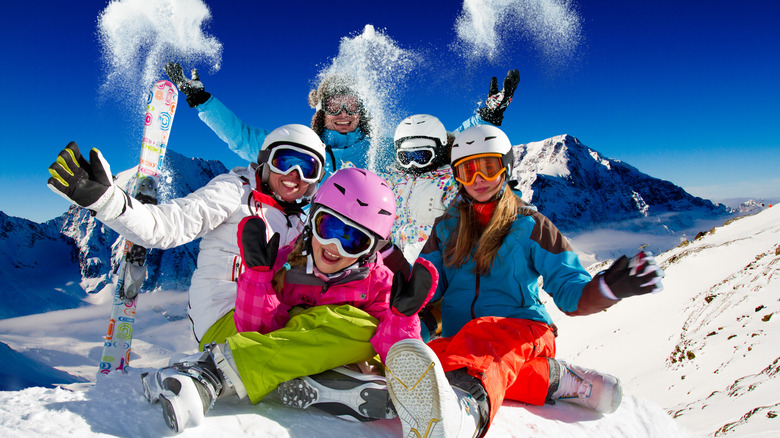Planning and packing for a family trip can be an ordeal. For a family ski vacation? Well, that takes equal parts art and science. Don’t let the magnitude of the undertaking put you off, though. As a wise person (maybe a mom?) once said, “Anything worth doing is worth doing right.” And many dedicated skiers would say that a family ski trip is definitely worth the effort.
Some of the things you’ll want to consider are whether you should rent or buy your equipment, what kind of essentials and accessories you should invest in, how to dress on and off the hill, what to do if you live in a snow-free place, the extras you’ll want to bring with you, and how to pack it all. Of course, you’ll have to figure out what works best for your unique and wonderful family, but with these tips, you’ll be ready to conquer mountains.
Buy your own gear if you ski often
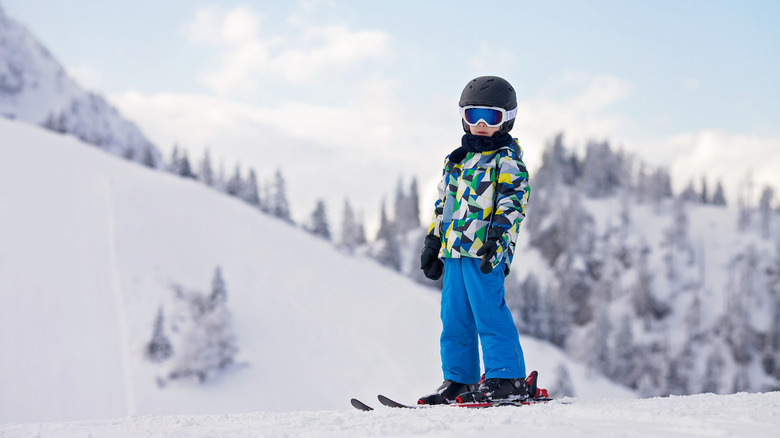
Owning your gear has some distinct advantages. You know what the equipment has been subjected to and you can vouch for the cleanliness (or at least know any grime is your own). When you buy new gear, you also have control over the quality of the equipment you are investing in. You know how often you will be using your gear and how hard you’ll be testing your gear. You can account for these things when contemplating your purchases. Equipment that does just fine for a few runs on the bunny hill might not be up for the challenge of many dedicated weeks on black diamond runs.
When it comes to kids, keep in mind they grow fast. You will likely need to buy new equipment each season until your kids reach their full-grown size. Keep an eye out for “I’ve Outgrown It” sales and equipment swaps. Ski clubs may host them at the end or start of the season, allowing you to offset expenses.
Buying equipment new can be expensive, no doubt, but compare the cost of entry-level or used gear to the cost of renting. If you plan to ski even a handful of times in the season and don’t require top-of-the-line equipment, it may be more cost-effective to buy rather than rent multiple times. You’ll be grateful for the time you save at the hill when you can bypass the lines at the rental shop.
Rent ski gear for the most convenience

Despite the fact you will likely have to spend time in line to get your gear, renting on the hill is generally the most convenient option. You don’t have to pack anything or lug wet equipment back home. Suitcase Tetris in the back of the rental car will be infinitely easier without the whole family’s skis, boots, and helmets vying for space.
Additionally, rentals are the definition of low commitment, allowing you to try it out before investing in gear — a boon if you aren’t sure your kids will love skiing. Some snow resorts will let you trade equipment during the day, giving skiers the chance to try snowboarding for a portion of the day, or vice versa. There are also special rates at some ski schools for first-timers that include rentals and a lesson for a special discounted rate. Pro tip: You can save some time at the rental shack if you know your and your kids’ current weight and height. Have the measurements in kilos and centimeters if you are at a European or Canadian ski resort.
You don’t have to rent on the hill
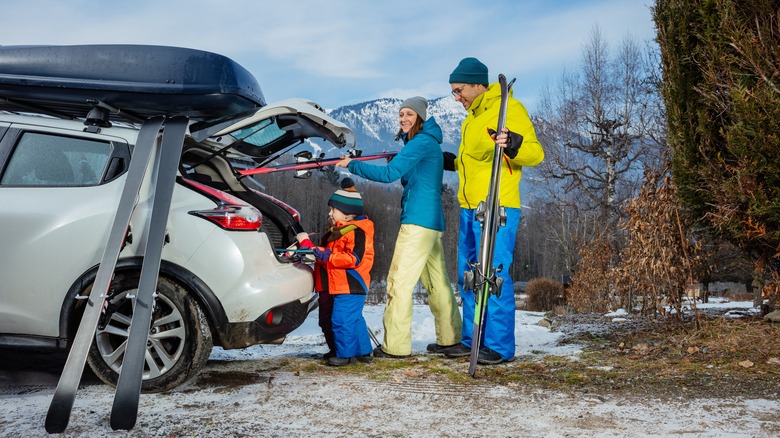
Sergey Novikov/Shutterstock
Renting on the hill isn’t your only option. While you may lose out on the on-hill convenience, the savings can make it more than worth it. Look for an outfitter for rentals. Sourcing your ski equipment in town gives you the chance to try it out at home, allowing the luxury of switching it up if needed before “going live” on the hill. If you live far from any ski resorts, it may be tough to find winter sports gear locally. In that case, research your options closer to the mountains. Your hotel concierge can steer you in the right direction if needed.
Outdoor clubs and sports organizations are another great resource for rentals. For example, if you are going on a ski vacation in the Canadian Rockies, check out the Outdoor Centre at the University of Calgary. Organizations like this strive to make outdoor activities more accessible to a wide range of people, so are generally economically priced, although you do have to reserve well in advance.
The downside to short-term or daily rentals from somewhere other than on the hill is that you still have to pack and bring your gear. Depending on how far from the hill your gear is from, you may end up paying for extra days to allow for pick-up and drop-off. Seasonal rentals might be the best for your situation, meaning you can keep the gear all winter without the commitment of buying outright.
Gather the essentials
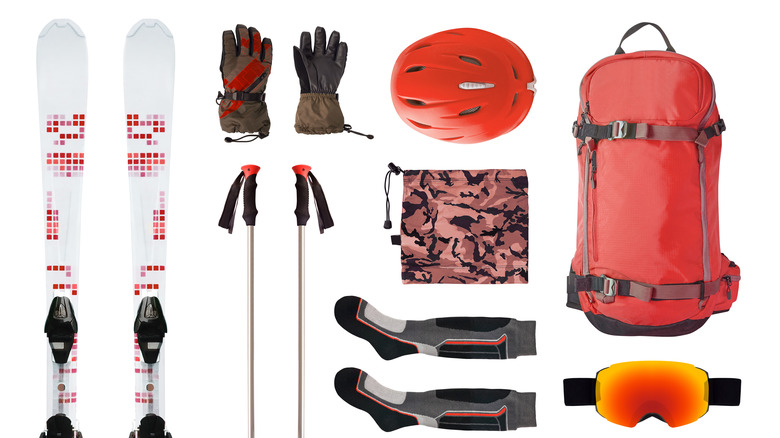
Lilkin/Shutterstock
Whether you are planning to rent or buy, you’ll need a few essentials. First, whether skis or a snowboard, one plank or two, the fit is paramount. When held vertically, the skis should reach somewhere between your chin and the top of your head. In general, a shorter ski is better for less-experienced skiers and those who prefer slower speeds. A chin-height snowboard is also a good place to start; beginners may want to go shorter and people with heavier bodies may want to try longer. The kind of snow you’ll be on and what you want to do will also affect what is best to strap to your feet. Poles are also part of the package for experienced skiers and should be fitted for your height. For newbies and kids, they generally aren’t necessary. Most beginner classes won’t even use them.
You also need waterproof outerwear. Being wet is a quick route to misery. Make sure your jacket, snow pants, and gloves or mittens are rated for water. While the sun reflecting off the snow may be dazzling, it’s hard on your peepers. Protect them with polarized or UV-protective goggles, which are less likely to fly off than sunglasses and have better coverage against the wind. Finally, balaclavas aren’t just for bank robbers! The one-piece head and face covering is ideal for cold-weather wear. Alternatively, opt for a knit cap and neck warmer. Scarves pose a risk of strangulation; don’t bring them to the hill. Most of all, protect that beautiful brain with a helmet.
Pick the right accessories
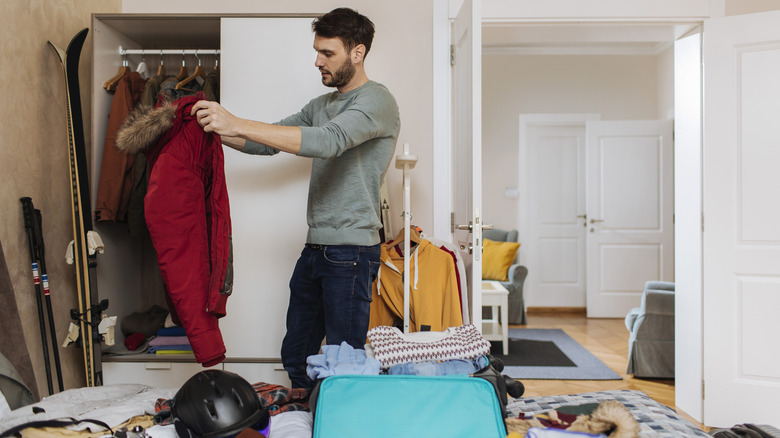
Mihailomilovanovic/Getty Images
Besides a nice warm base layer, there are a few key accessories that also belong on your packing list. Quality socks with merino wool are thin and soft with moisture-wicking capabilities to keep your tootsies nice and dry. There are also synthetic alternatives that do a good job, and you can also find socks with cushioning on the sole and along the shin for extra padding at pinch points.
If you’re going off-piste, you’ll need to take winter safety precautions and have a host of snow safety products, but even assuming you and your family are staying on the trails, a plastic (metal will stick to lips in the cold) whistle is a handy tool. Attach it to your kids’ jackets and teach them it should only be blown if they need help. When skiing with kids (or adults), a mitten or glove dropping off the chair lift is common. Avoid it with mitten strings. Run a sturdy string inside the arms of your child’s jacket along the back, attaching each end to one of the gloves. If you can’t tie them on, use binder clips or check Pinterest for tutorials. If the string is too cumbersome, use pacifier straps.
Finally, if you’re going somewhere particularly cold, you may consider hand warmers. These small foil envelopes slip inside mitts or gloves for a bit of toasty comfort. They work similarly to a glow stick, where the chemical reaction starts when you bend the package or give it a little shake. They work tucked into boots too!
Dress properly with the three-layer system
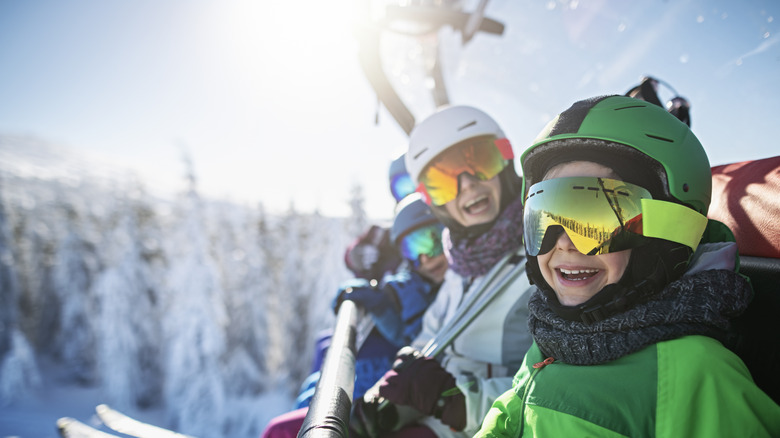
Imgorthand/Getty Images
Dressing in layers is the best way to stay cozy out in the elements. The three-layer system consists of a base layer made from a material that pulls dampness from sweat away from your skin (known as “moisture-wicking”), followed by an insulating mid-layer, and a waterproof outer layer. Long or thermal underwear is a standard base layer. A soft merino wool is lovely but expensive. Synthetic alternatives abound and can do a very good job. Avoid anything cotton, as once it gets wet, it will stay wet, and that is a recipe for a miserable experience.
The middle layer should help keep you warm. It should be loose enough to fit over the base layer and allow you to move comfortably, but not bulky enough to bind under the outer layer. Think track pants and a fleece jacket. The middle layer should be something that can be fairly easily removed, in case you find yourself getting too warm.
The outer layer is all about keeping the elements out. Look for labels that say wind-resistant and waterproof. Pro tip: Let your kids try on the clothes ahead of time, especially if they have any sensory issues. Don’t let an annoying tag or itchy sweater collar keep your kid from having a great day out on the hill.
Be footwear aware
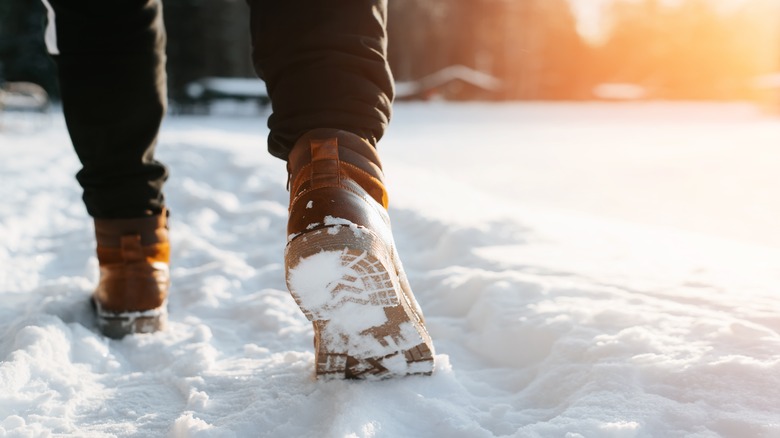
Sergio Photone/Shutterstock
Footwear is bulky and takes up a lot of room in your luggage. Extra shoes or boots may mean you end up paying an overweight luggage fee at the airport, which is easily avoidable if you carefully consider what your needs are before you start packing for your ski vacation.
If you aren’t planning to rent, you will need to bring your ski boots, obviously. For off-the-hill time, your regular snow boots should suffice. If you don’t already have boots and aren’t planning intense outdoor activities, rubber boots and warm socks work fine.
It’s unlikely you will need shoes unless you are spring skiing, spending a lot of time at a lower (no longer snowy elevation), or plan to be doing things that require formal dress. Ski resort towns tend to have a very casual vibe, so even if you are going to upscale restaurants, you probably won’t be violating any dress codes or even raising any eyebrows with your snow boots.
What to do if you live in a warm weather spot
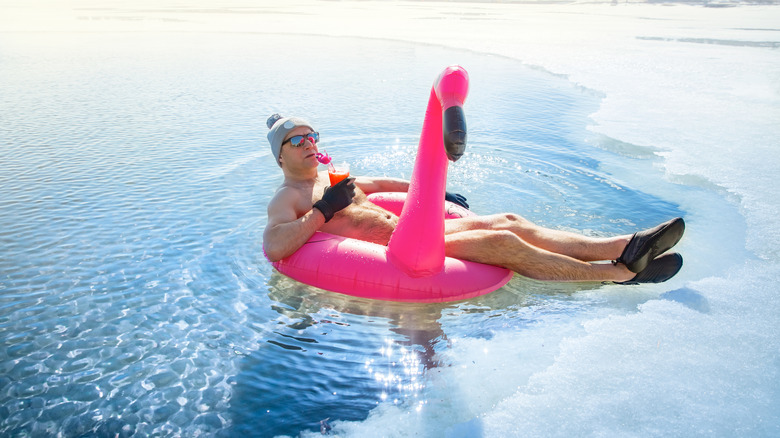
Suzi Media Production/Getty Images
If you live in a place where winter is part of the drill, you already own the necessary cold weather accouterments. If snow is a rare occurrence where you live, though, chances are slim you have an abundance of mitts and woolen hats cluttering up your foyer. The thought of investing in a whole new wardrobe just for a ski trip can be daunting. So what to do?
First of all, you can put the word out and borrow from your network. Even if the gear is coming from far away, paying to have it shipped to you is likely less costly than buying. Also, check online second-hand markets like Poshmark, eBay, and Facebook marketplace. Start trawling the sites well ahead of your trip. If you strike out online, you may need to buy when you get to your destination. Second-hand shops in winter locations have more winter gear, especially for kids, who tend to only wear things for one season before they grow into the next size. Department and sportswear stores are also worth checking out, but note that retail seasons rarely have much in common with actual weather, so the selection of winter wear can be very sparse to non-existent by mid-season.
Stock a day bag for the hill
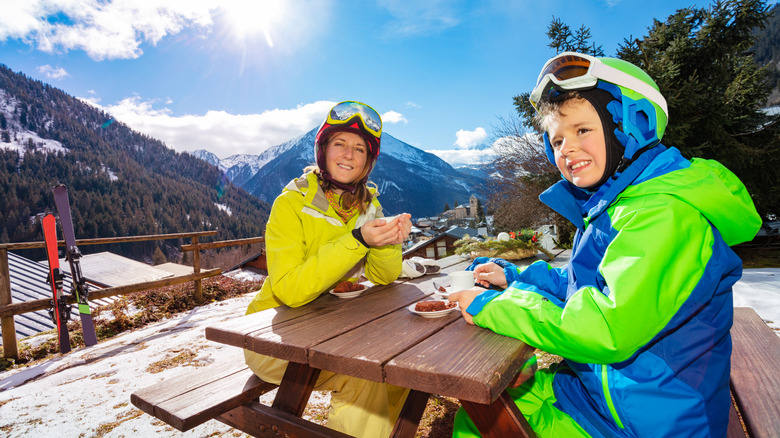
Serrnovik/Getty Images
Packing for your ski day is almost as important as packing for the trip. Stock your daypack with the essentials you want to have easily accessible and store the bag in the lockers at the chalet. If your family will be sticking together for the duration, one big backpack should suffice. In addition to your lunches (if you don’t want to buy them,) pack some extra clothes, snacks, sunscreen, and SPF lip balm. Hot chocolate powder can make even gross cafeteria coffee palatable, and there is usually hot water available if you want to mix some up for the kids.
If your kids will be at the daycare or are taking part in a program where they take ski lessons for half the day and hang out at a kids’ club until you pick them up, pack separate bags for each child — their regular school backpack fits the bill nicely. Include a water bottle, snacks (peanut/nut-free may be required), and dry socks. Pro tip: Make sure you label everything. Hockey tape is durable and waterproof, making it ideal for marking names on helmets and skis.
Have a plan to stay in touch
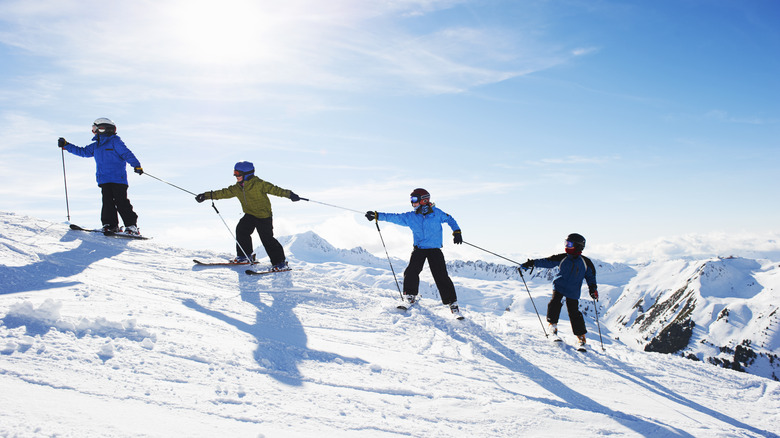
Adie Bush/Getty Images
Even small ski resorts are easy to get lost in. Depending on the ages and skiing ability among your group, it’s conceivable you’ll also split up on purpose. Mobile phones are often the default communication mode for families but don’t count on cell service at the top of a mountain. Walkie-talkies can be a good solution, although that means one more thing to carry during the day, which may be less than ideal.
Designate a muster point to meet if you get separated, or make a plan to meet regularly and check in with each other. Make sure everyone has a watch that they know how to use. Analog watches can be tough for kids to get the hang of, so digital may be the way to go unless you are confident they can read a dial. Tuck a card with your contact info in your kids’ inside jacket pocket and tell them it’s there, or write your name and number (if there is cell service where you are) with a marker on their forearm.
Comfort is key for apres-ski
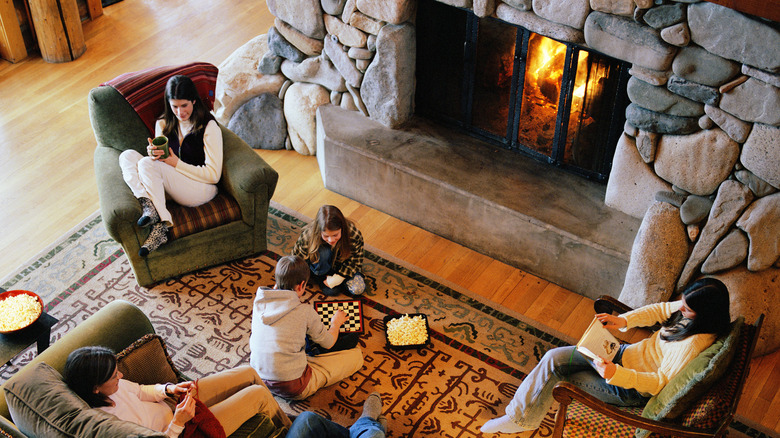
Ryan Mcvay/Getty Images
You already know packing for a ski vacation entails a lot of gear. The good news is that you can get away with packing far less regular clothing than you would for any other sort of trip. If the main focus of your trip is skiing, then you aren’t going to require very much clothing other than what you wear on the hill. Two additional outfits are likely enough: travel clothes and a going-out outfit, and honestly, you may not even need the going-out clothes.
After a long day outside, you and the kiddos are going to be tired in the evenings. Ordering dinner in and lounging in your long johns or PJs may be all you want to do. Don’t fight it. There is nothing worse than pushing overtired kids to behave for a restaurant meal, especially when you are feeling tired yourself. Embrace the hygge of your ski lodgings and tuck in for a cozy night in — no fancy clothes required.
Pack your ski gear in a hockey bag
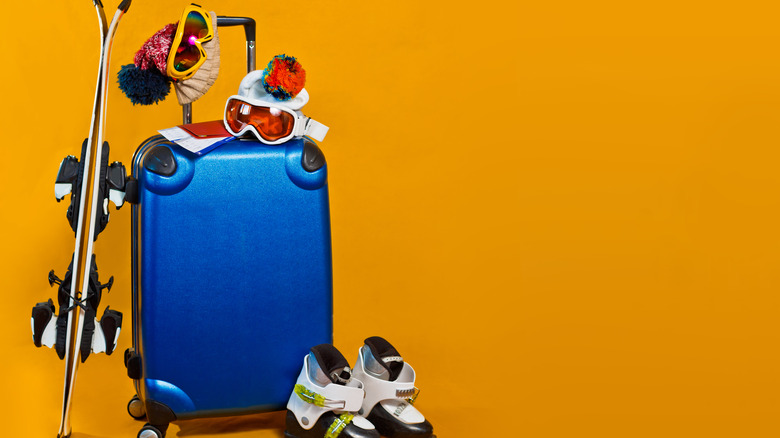
Petrovicheva Mariia/Shutterstock
Ski boots, helmets, bulky jackets, and snow pants … it’s going to take a mammoth-sized suitcase to fit it all! A hockey bag can be your best friend. They are designed to carry a load of gear and feature dedicated helmet compartments and roomy side pockets to stash mitts and hats. Depending on the size, you may be able to stuff gear (everything but the skis!) for several members of the family into one bag. And bonus, many styles of hockey bags have wheels to ease your way through the airport and down long hotel hallways.
Remember that you will likely have to pay for oversized baggage if you are flying. If it proves to be an unmanageable amount of luggage, consider a mix-and-match approach to renting. For example, you may want your own helmet but content to rent skis. Or, the parents may want to bring their own ski equipment and pick up rentals for the kids at the resort.
Another packing tip to bear in mind: Keep each person’s gear together. Labels can help keep things easily identifiable, particularly helpful if you have family members who wear similar sizes. Separating the gear according to who will wear what makes it a breeze for each person to grab a bundle and get dressed rather than sorting through a pile.

